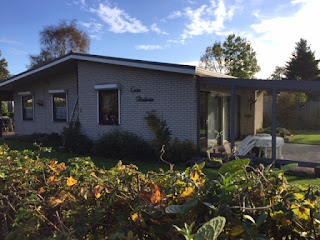We decided to escape the relentless cold wind of the past four days and head for better weather in the province of Almeria. It turned out to be a great decision. We were able to explore a new area and even briefly splash in the Mediterranean. Surprisingly, it was less than a two hour drive to the famous coastal town of Mojácar. We arrived in to late afternoon sunshine and took a walk on the narrow, steep, windy streets of the presently quiet tourist town nestled in the foothills of the Sierra Cabrera. One of the interesting things we noticed was nearly all of the roofs in this area are flat. They are reminiscent of Moorish inspired Mudejar architecture style; but we guessed it is probably because there is no snow and not a ton of rain to deal with!
View from the highest point of Mojacar - around 200m above sea level
 glass topped wall and a roof decoration
glass topped wall and a roof decoration

hand sanitizer instead of holy water for the sign of the cross
We were able to pick some delicious oranges right off of the trees!
We ended the day driving past the numerous white sandy beaches of Mojacar. There were a few people around eating outside at some of the many beach side restaurants. We were looking for a place to park and camp for the night and headed out a gravel road past the 18th century Castillo de Macenas.
The following morning we awoke to a stunning sunrise, a welcome change after the past cold and windy week...
Watchtower - Torre del Pirulico (XIII - XIV) we camped below
Looking the other direction is a house with a view! (look carefully on top of the flat mountain).
Later in the morning we ran over this hill and then explored the coast further down the dead end road we had camped on. There were two small, colorful, smooth pebbled cove beaches with 6 -7 other campers parked there. It was a surprise to see other campers: two German, a Dutch, Slovenian, Swiss and French!
After our run, Herman was braver than me and dove into the Mediterranean to cool off.
A tiny outdoor oven Interesting, kind of creepy, erosion patterns are abundant in the area
We drove on further into the Parque Natural de Cabo de Gata to the town of Agua Amarga "Bitter Water". The name dates back to the late 1800's when the area was mined and the chemicals used in the process tainted the wells. Today it is a pristine seaside town with a lovely character. There are eroded cave dwellings that date back to the 18th -19th centuries and were inhabited by the rail and iron industry workers.
Lighthouse above Agua Amargo
Sunrise and sunsets were both phenomenal from our camping spot. We watched from the top of SAM



Cave dwellings on Cuartel Hill. Herman for scale in a cave dwelling entrance


The final night of this excursion, we spent San José which is a small fishing pueblo in the center of the Parque Natural de Cabo de Gata. This town is a few kilometers from a famous beach, Los Genoveses and is surrounded by Agave and European Fan Palms. We camped on the edge of town and although we first explored by bicycle, we found we were able to easily walk to the grocery, bakery, beaches and port. The following morning we did a longer ride and short hike at Los Genoveses. We spent the early afternoon in the warm sunshine playing jeux des boules, reading and running on the beach.
Buildings and beach in San Jose
View from where we parked for the night
A grain mill with Herman for scale (look carefully)
Biking on Playa de Los Genoveses Goat! Agave and Fan Palms
On the mountain near the beach looking back at San Jose. It is easy to see the volcanic roots of this area.





















































Simply put...your photos and historic commentary are all so INCREDIBLE!!! Ed and I just finished this excursion with you and loved the photos as well that included your smiling and energetic selves. Feliz Navidad, Diana and Ed
ReplyDelete